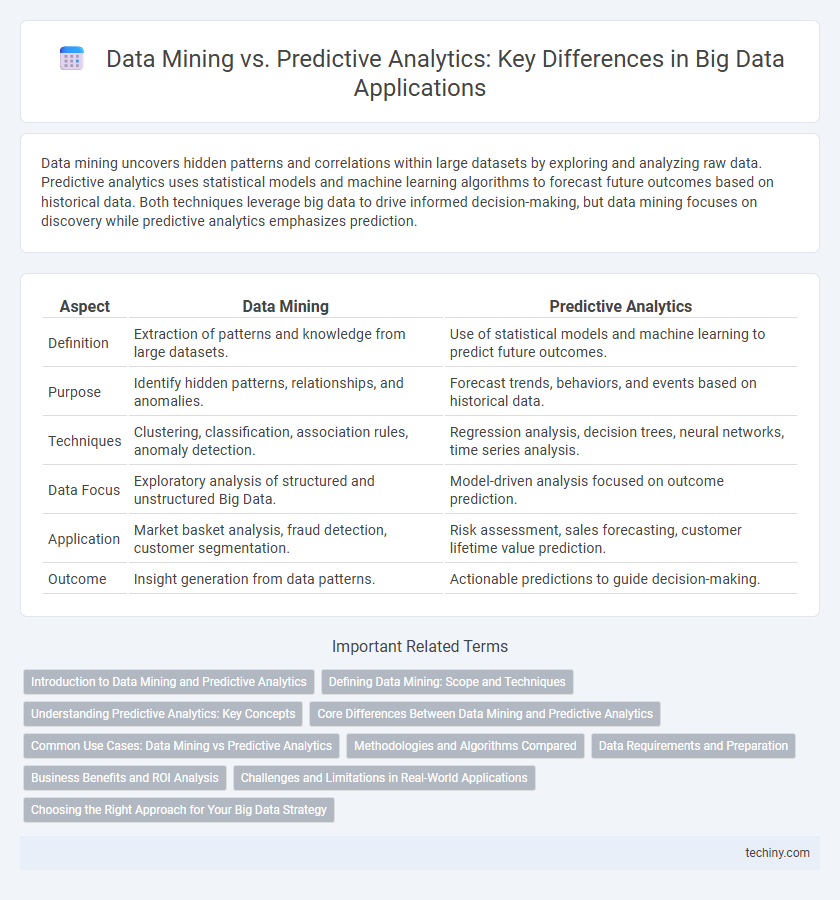Data mining uncovers hidden patterns and correlations within large datasets by exploring and analyzing raw data. Predictive analytics uses statistical models and machine learning algorithms to forecast future outcomes based on historical data. Both techniques leverage big data to drive informed decision-making, but data mining focuses on discovery while predictive analytics emphasizes prediction.
Table of Comparison
| Aspect | Data Mining | Predictive Analytics |
|---|---|---|
| Definition | Extraction of patterns and knowledge from large datasets. | Use of statistical models and machine learning to predict future outcomes. |
| Purpose | Identify hidden patterns, relationships, and anomalies. | Forecast trends, behaviors, and events based on historical data. |
| Techniques | Clustering, classification, association rules, anomaly detection. | Regression analysis, decision trees, neural networks, time series analysis. |
| Data Focus | Exploratory analysis of structured and unstructured Big Data. | Model-driven analysis focused on outcome prediction. |
| Application | Market basket analysis, fraud detection, customer segmentation. | Risk assessment, sales forecasting, customer lifetime value prediction. |
| Outcome | Insight generation from data patterns. | Actionable predictions to guide decision-making. |
Introduction to Data Mining and Predictive Analytics
Data mining involves extracting meaningful patterns and knowledge from large datasets using techniques like clustering, classification, and association rule learning. Predictive analytics utilizes statistical algorithms and machine learning models to analyze historical data and forecast future trends or behaviors. Both fields leverage big data but differ in purpose: data mining uncovers hidden information while predictive analytics focuses on making informed predictions.
Defining Data Mining: Scope and Techniques
Data mining involves extracting meaningful patterns and knowledge from large datasets using statistical, machine learning, and database systems techniques. Key methods include clustering, classification, association rule mining, and anomaly detection, which help uncover hidden relationships and trends within big data. Its scope encompasses data preprocessing, pattern evaluation, and knowledge representation to support decision-making across diverse industries.
Understanding Predictive Analytics: Key Concepts
Predictive analytics uses statistical algorithms, machine learning models, and historical data to identify the likelihood of future outcomes, enabling proactive decision-making. Key concepts include regression analysis, classification, clustering, and time series forecasting to uncover hidden patterns and trends within large datasets. This approach differs from traditional data mining by emphasizing outcome prediction rather than solely exploring data relationships.
Core Differences Between Data Mining and Predictive Analytics
Data mining involves extracting hidden patterns and relationships from large datasets using techniques like clustering, classification, and association rule mining, whereas predictive analytics uses historical data models to forecast future trends and outcomes. Data mining primarily focuses on discovering unknown insights within data, while predictive analytics emphasizes using these insights to make informed predictions and decisions. The core difference lies in data mining's exploratory nature contrasted with predictive analytics' goal of anticipating future events based on analyzed data.
Common Use Cases: Data Mining vs Predictive Analytics
Data mining uncovers hidden patterns and correlations within large datasets, commonly used for customer segmentation, fraud detection, and market basket analysis. Predictive analytics leverages historical data and statistical algorithms to forecast future outcomes, frequently applied in sales forecasting, risk assessment, and demand planning. Both techniques optimize decision-making by extracting actionable insights, driving competitive advantage in various industries.
Methodologies and Algorithms Compared
Data mining employs methodologies such as clustering, association rule learning, and anomaly detection to uncover hidden patterns within large datasets. Predictive analytics primarily uses regression analysis, decision trees, and machine learning algorithms like random forests and neural networks to forecast future outcomes based on historical data. While data mining emphasizes pattern discovery, predictive analytics focuses on building models for accurate prediction using data-driven algorithms.
Data Requirements and Preparation
Data mining requires extensive cleaning and integration of large, diverse datasets to uncover hidden patterns and relationships, emphasizing the need for high-quality, well-structured data. Predictive analytics depends on historical data that is precise, consistent, and often preprocessed with feature engineering to build accurate models for forecasting future trends. Both processes necessitate significant data preparation, but predictive analytics demands a more targeted approach to selecting relevant variables for model training.
Business Benefits and ROI Analysis
Data mining uncovers hidden patterns and correlations within large datasets, enabling businesses to identify opportunities and risks that drive informed decision-making. Predictive analytics leverages historical data and statistical models to forecast future outcomes, enhancing strategic planning and improving resource allocation. Both approaches increase ROI by optimizing marketing efforts, reducing operational costs, and boosting customer retention through data-driven insights.
Challenges and Limitations in Real-World Applications
Data mining faces challenges such as handling massive, unstructured datasets and dealing with noisy or incomplete data, which can hinder accurate pattern extraction. Predictive analytics struggles with model overfitting, bias from poor-quality training data, and difficulties in interpreting complex algorithm outputs in dynamic, real-world environments. Both techniques require robust data governance and continuous validation to ensure reliability and actionable insights within Big Data ecosystems.
Choosing the Right Approach for Your Big Data Strategy
Data mining extracts hidden patterns and relationships from vast datasets, enabling businesses to discover valuable insights without predefined hypotheses. Predictive analytics uses historical data and statistical models to forecast future outcomes, driving informed decision-making through trend anticipation. Selecting the right approach depends on your Big Data objectives--opt for data mining when exploring unknown patterns and predictive analytics to support proactive strategy with accurate predictions.
Data Mining vs Predictive Analytics Infographic

 techiny.com
techiny.com